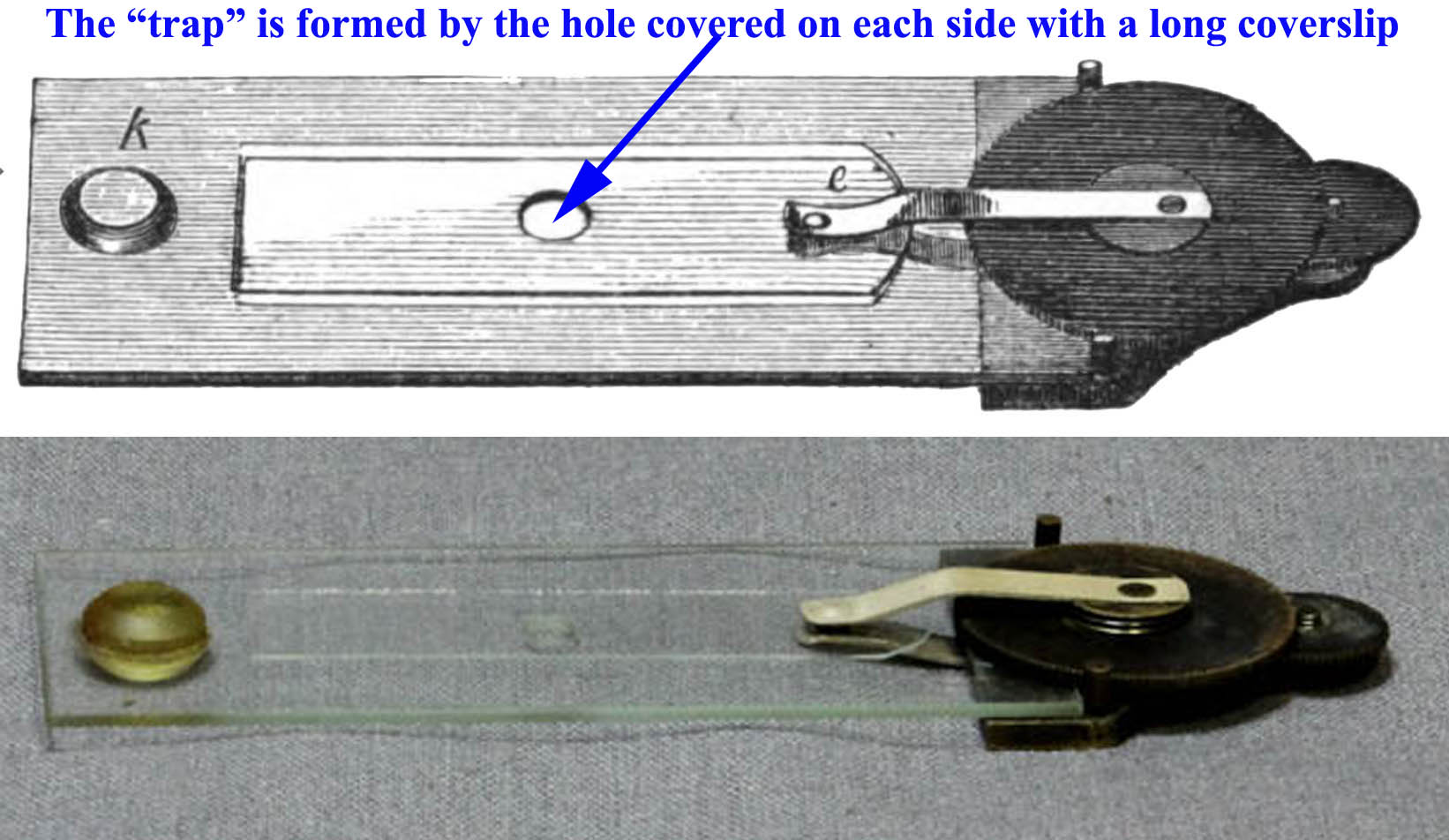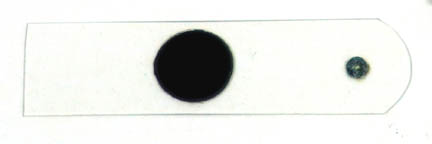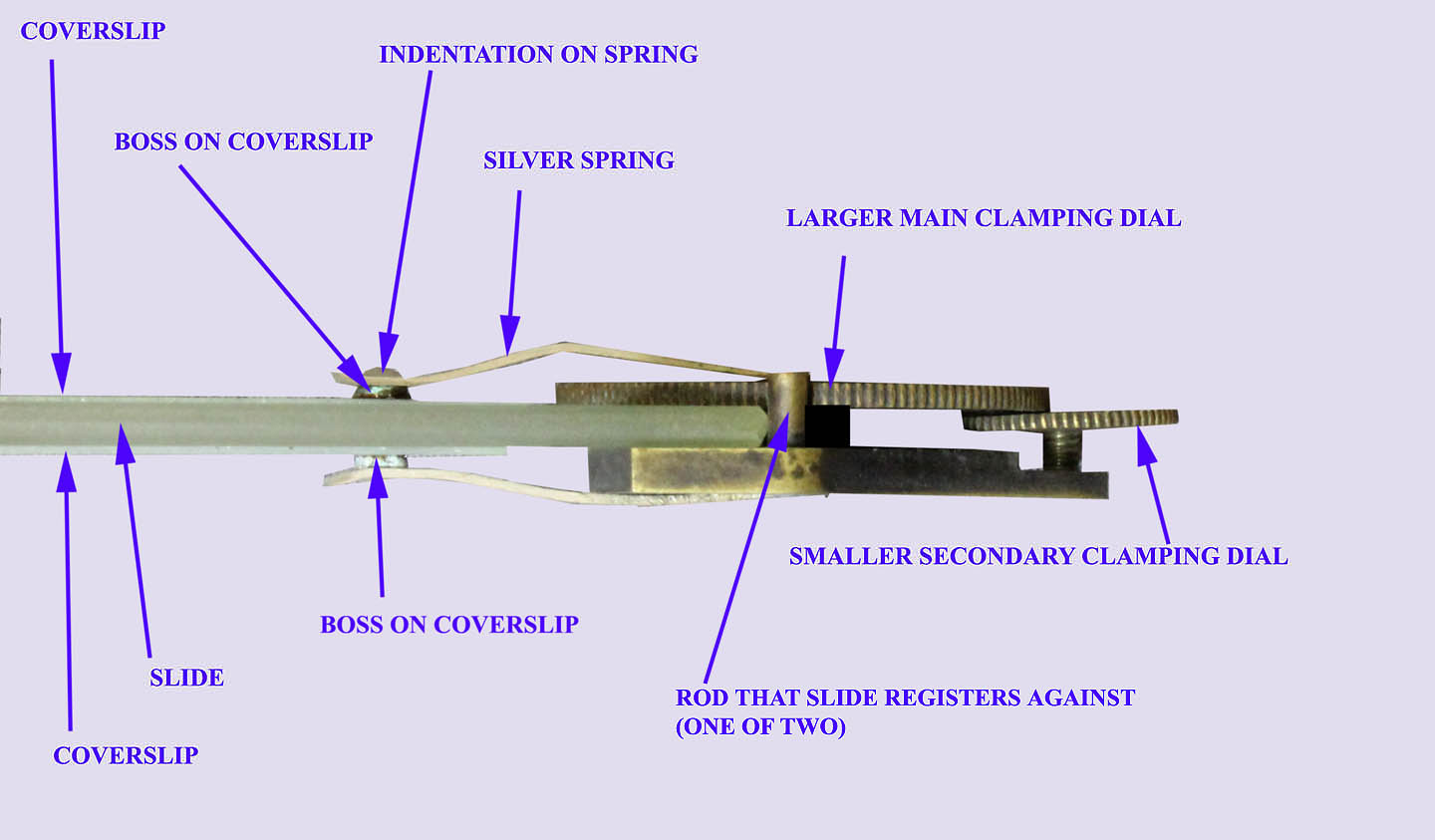BECK 'LIVE TRAP' KIT
MAKER:Smith, Beck, & Beck
DATE: After 1865
Please Click On Any Picture for a Larger Version
INTRODUCTION:  As time went on, microscopists developed various accessories to assist them in using microscopes to study living-and moving, organisms. When it came to a portion of water full of lots of organisms, a live box or a compressor would suffice. But for smaller organisms, especially single organisms, using such large accessories was fraught with difficulty; with a live box, the organism would be relatively free to move outside the field of view. The compressor would restrain the organism, but this might also distort its structure or movements. This troubled Richard Beck and so, apparently after trying various arrangements, he came up with the 'Live Trap' system, which trapped organisms in a small space appropriate to their individual size, while not crushing them or impeding them except for limiting the space in which they could travel. He provided three different slides with different size chambers (holes) for this. The 'trap' is formed by the hole, with a cover slip on each side of it 'trapping' the subject inside the hole between the two coverslips. He also came up with a metal fitting designed to hold the coverslips in place without damaging the slide or the coverslips. He designed this fitting to be easily attached or removed for cleaning the glass parts.
As time went on, microscopists developed various accessories to assist them in using microscopes to study living-and moving, organisms. When it came to a portion of water full of lots of organisms, a live box or a compressor would suffice. But for smaller organisms, especially single organisms, using such large accessories was fraught with difficulty; with a live box, the organism would be relatively free to move outside the field of view. The compressor would restrain the organism, but this might also distort its structure or movements. This troubled Richard Beck and so, apparently after trying various arrangements, he came up with the 'Live Trap' system, which trapped organisms in a small space appropriate to their individual size, while not crushing them or impeding them except for limiting the space in which they could travel. He provided three different slides with different size chambers (holes) for this. The 'trap' is formed by the hole, with a cover slip on each side of it 'trapping' the subject inside the hole between the two coverslips. He also came up with a metal fitting designed to hold the coverslips in place without damaging the slide or the coverslips. He designed this fitting to be easily attached or removed for cleaning the glass parts.
DESCRIPTION AND USE:
This is a fine example of a Beck Live Trap kit. The polished mahogany case contains two spring fittings each designed to hold a spring on each side of the slide. One of these has iron springs and the other one has silver springs. These springs strongly resemble ordinary microscope stage clips. The spring fittings attach to the end of the supplied special glass or brass slides, each about 0.9 wide X 2 ½ inches in length. Three glass and three blackened brass slides are supplied. The glass slides measure about 1.75 mm, 1 mm, and 0.35 mm in thickness corresponding to 6.8 hundredths, 3.9 hundredths, and 1.4 hundredths of an inch; this compares reasonably well with Richard Beck's quoted 6, 4 and 2 100ths. These slides have holes drilled in them of 3.9 mm, 2.7 mm, and 2.35 mm respectively; the thicker the slide, the larger the hole. The blackened brass slides measure 1.35 mm, 0.9 mm, and 0.5 mm in thickness, and also have holes, measuring 3.6 mm, 2.7 mm, and 2.1 mm in diameter respectively. Note these measurements are slightly different from the glass ones. Both the glass and brass slides have a boss on both sides of one end to balance the thickness of the spring apparatus to maintain the slide in a horizontal position on the stage. Also contained in the case is a small red and white cardboard box which holds the special coverslips.
 According to the descriptions of this kit, cover slips with a black disc as well as a frosted disc were also aupplied. Although neither one was present in this kit when I received it, an example of the black disk coverslip is shown to the left, courtesy of Dr Joe Zeligs.
According to the descriptions of this kit, cover slips with a black disc as well as a frosted disc were also aupplied. Although neither one was present in this kit when I received it, an example of the black disk coverslip is shown to the left, courtesy of Dr Joe Zeligs.
 The fittings that hold the springs in place attach to the end of the slides. The end of the slide rests against two little posts on either side of the large dial. These fittings that hold the springs are secured to the slide by screwing down a large brass dial to the slide, and then screwing a smaller dial upward to reduce the chance of the large dial loosening and also applying slight pressure that tilts the larger disc down to grip the slide.
The fittings that hold the springs in place attach to the end of the slides. The end of the slide rests against two little posts on either side of the large dial. These fittings that hold the springs are secured to the slide by screwing down a large brass dial to the slide, and then screwing a smaller dial upward to reduce the chance of the large dial loosening and also applying slight pressure that tilts the larger disc down to grip the slide.
Once the springs are attached to the slide, the special oblong coverslips, each with a tiny brass boss on one end, fit under the springs, one on each side of the slide; the little brass boss fits into an indentation on the underside of each spring. This serves to prevent the cover slip from falling off, yet allows it to be turned aside if needed.
If a dry specimen, like a small fly is to be studied, the brass slides and iron springs can be used, but with liquid specimens the glass slides and silver springs are used lest the metal parts develop rust and verdigris. Because the springs are quite thin, rust can rapidly destroy the iron ones-in fact one of the iron springs has rusted away on the example in this kit.
Because a wet specimen will tend to dry out, a trough is provided. The end of the slide opposite the springs can be immersed in the trough, with the ends of the cover slips under the liquid, keeping the specimen wet by 'capillary attraction'.
HISTORY AND NOTES ABOUT THE BECK 'LIVE TRAP':
The device was apparently first described by Richard Beck in the Transactions of the RMS, the description being read before the society on June 14, 1865. It is shown in Beck's Treatise of that same year, and continued to be offered and illustrated in the Beck catalog of 1882. From the scarcity of these devices, one gets the feeling that most microscopists preferred live boxes and compressors rather than this type of instrument to confine their subjects, even though this device has the advantage of confining the subjects to a much smaller space without any compression or damage.
 As time went on, microscopists developed various accessories to assist them in using microscopes to study living-and moving, organisms. When it came to a portion of water full of lots of organisms, a live box or a compressor would suffice. But for smaller organisms, especially single organisms, using such large accessories was fraught with difficulty; with a live box, the organism would be relatively free to move outside the field of view. The compressor would restrain the organism, but this might also distort its structure or movements. This troubled Richard Beck and so, apparently after trying various arrangements, he came up with the 'Live Trap' system, which trapped organisms in a small space appropriate to their individual size, while not crushing them or impeding them except for limiting the space in which they could travel. He provided three different slides with different size chambers (holes) for this. The 'trap' is formed by the hole, with a cover slip on each side of it 'trapping' the subject inside the hole between the two coverslips. He also came up with a metal fitting designed to hold the coverslips in place without damaging the slide or the coverslips. He designed this fitting to be easily attached or removed for cleaning the glass parts.
As time went on, microscopists developed various accessories to assist them in using microscopes to study living-and moving, organisms. When it came to a portion of water full of lots of organisms, a live box or a compressor would suffice. But for smaller organisms, especially single organisms, using such large accessories was fraught with difficulty; with a live box, the organism would be relatively free to move outside the field of view. The compressor would restrain the organism, but this might also distort its structure or movements. This troubled Richard Beck and so, apparently after trying various arrangements, he came up with the 'Live Trap' system, which trapped organisms in a small space appropriate to their individual size, while not crushing them or impeding them except for limiting the space in which they could travel. He provided three different slides with different size chambers (holes) for this. The 'trap' is formed by the hole, with a cover slip on each side of it 'trapping' the subject inside the hole between the two coverslips. He also came up with a metal fitting designed to hold the coverslips in place without damaging the slide or the coverslips. He designed this fitting to be easily attached or removed for cleaning the glass parts.
 According to the descriptions of this kit, cover slips with a black disc as well as a frosted disc were also aupplied. Although neither one was present in this kit when I received it, an example of the black disk coverslip is shown to the left, courtesy of Dr Joe Zeligs.
According to the descriptions of this kit, cover slips with a black disc as well as a frosted disc were also aupplied. Although neither one was present in this kit when I received it, an example of the black disk coverslip is shown to the left, courtesy of Dr Joe Zeligs.  The fittings that hold the springs in place attach to the end of the slides. The end of the slide rests against two little posts on either side of the large dial. These fittings that hold the springs are secured to the slide by screwing down a large brass dial to the slide, and then screwing a smaller dial upward to reduce the chance of the large dial loosening and also applying slight pressure that tilts the larger disc down to grip the slide.
The fittings that hold the springs in place attach to the end of the slides. The end of the slide rests against two little posts on either side of the large dial. These fittings that hold the springs are secured to the slide by screwing down a large brass dial to the slide, and then screwing a smaller dial upward to reduce the chance of the large dial loosening and also applying slight pressure that tilts the larger disc down to grip the slide.